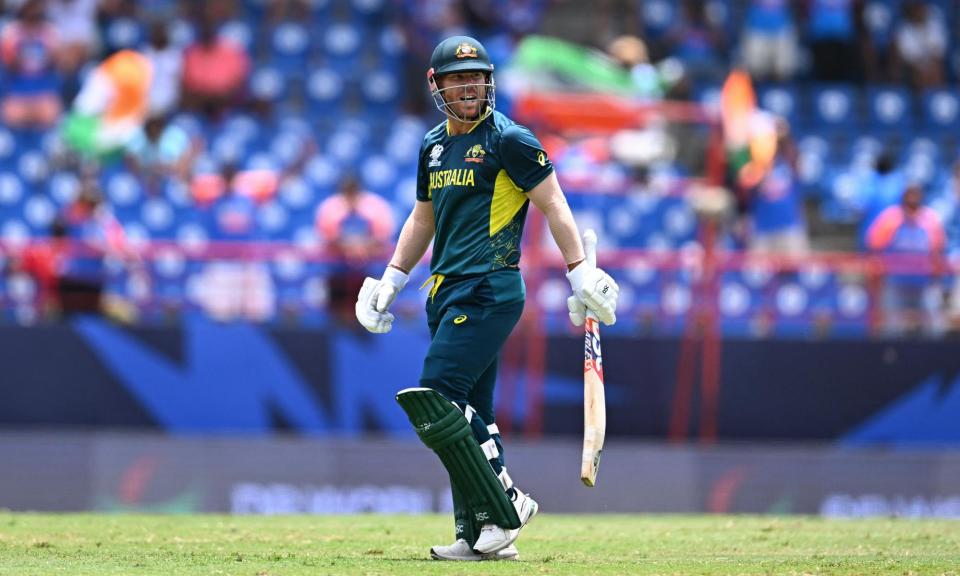
Most often, in trying to assess a sporting team’s tournament, you may as well be looking for the future in chicken entrails. Throw enough offal and you can interpret it as any shape you like.
Australia’s T20 World Cup campaign can go a couple of ways. Look at the struggles against lower-ranked teams and you can see a side that never hit its straps. Australia lost nearly half a game against Oman, three-quarters of a game against Scotland, and finally an entire costly one against Afghanistan. Marcus Stoinis rescued the first two with a bit of help, but nobody could ride with Glenn Maxwell to save the third.
Yet between times, the same team destroyed the defending champions England in a pure rush of attacking cricket, cruised past a Bangladesh team whose bowlers at least gave most sides some trouble, and dismissed Namibia in the way that the best-funded teams should expect to beat smaller sides.
Related: England set to discover if they created T20 monster by jolting India into life
Even the tournament-ending loss to India was a surprisingly good showing against a flexing favourite. With the manic schedule, Australia’s players would at best have got to bed by 2am after the disappointment of the Afghanistan defeat, then had an early-morning wake up 25 hours later to play India, having switched countries in the interim. Unsurprisingly sluggish to start, they pulled back the second half of their bowling innings well after Rohit Sharma’s ram-raid, and were ahead of the rate via Maxwell and Travis Head halfway through the chase. It wasn’t the performance of a team with departure-lounge syndrome.
So what went wrong? Usually this question is answered by personnel, but this team appeared well selected. It may be unimaginative to go for the big three quicks, copy-pasting the attack used in the last one-day World Cup and in most Australian Test matches for the last seven years. But Mitchell Starc had just finished bowling Kolkata Knight Riders to the IPL title, Pat Cummins is now a middle-and-death beast who took hat-tricks in consecutive matches, and in a world of battered bowlers, Josh Hazlewood has become a shadow creature that few can lay glove on. Four overs taking one for 14 was a Houdini act as India plundered every one of his colleagues.
The batting seemed balanced, with the top order firing often enough while the middle order backed it up when they didn’t. At least until Afghanistan, where any modest partnership might have made the difference but none was to be found. In the two losses, the late hitters in Stoinis, Tim David and Matthew Wade fizzled, but that risk is a T20 numbers game.
Jake Fraser-McGurk with his fast starts could have been handy chasing 206 against India on a decent pitch, but he never made the formal squad. David Warner showed against England that he could still be explosive but didn’t replicate it when it was really needed against India.
In the end, his final match for Australia was innocuous, on the fringes of national attention, edging to slip for six at about 2am Sydney time, out to a bowler who was nine years old when Warner made his debut. Others may follow him out the door in the buildup towards the next 20-over tournament in 2026: Wade, Stoinis, and perhaps some of the fast bowlers are most likely.
For Warner and anyone else in his position, it must have been strange not actually knowing whether it was their last match until nearly 1am local time, when the final outing of the Super Eight stage dragged to its end and the semi-final place was decided. You wouldn’t say that Warner has ever needed Bangladesh, except as a place to play domestic T20s during the year of his sandpaper ban.
He needed them now, as they stuttered and stumbled towards Afghanistan’s paltry 115 and ultimately got themselves bowled out just short, sending the Afghans through instead. After all of Cricket Australia’s cancelled tours and years of ignoring the Bangladesh team, it was rich to expect a favour.
Had they scraped through on that basis, these Australian players probably would have felt that they didn’t deserve the spot. They would have accepted the reprieve with a degree of embarrassment, although they would still have been a great chance to put that aside and spook South Africa again in a semi-final.
But on their early path home they will accept that it was down to not being good enough when it mattered. The same teams on another day and it might have been different. Especially in T20 cricket, it can be hard to know much more than that.
Article courtesy of
Source link